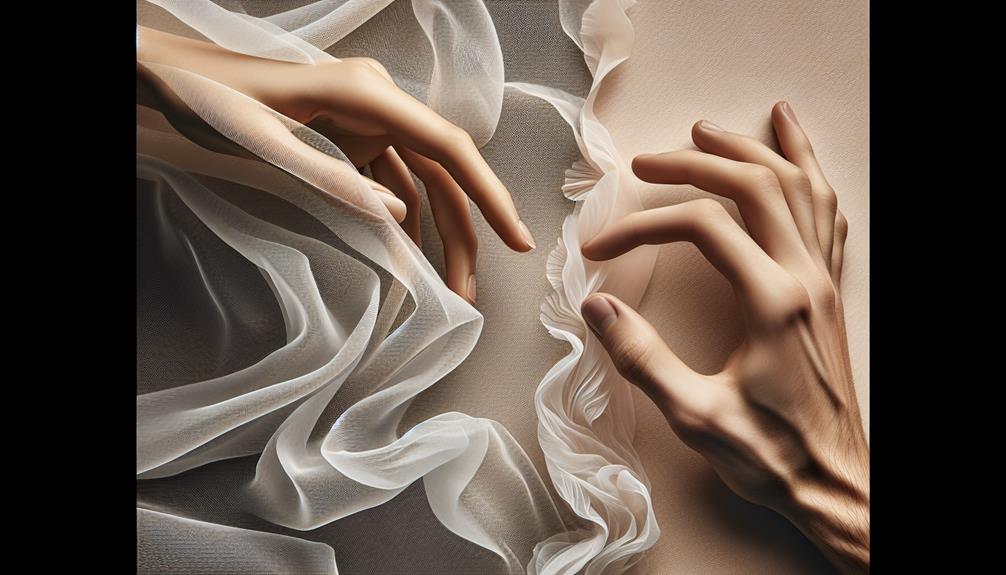Organza often catches people off guard with its versatility. Typically, it feels quite crisp and stiff, primarily due to the high tension in the warp during weaving and certain finishes like calendaring. This stiffness makes it fantastic for adding structure to garments like a poofy wedding dress. However, the base fiber—silk, polyester, or nylon—also plays a huge part. Silk organza leans towards a softer feel, adding a touch of flow to its structured nature. If you're curious, different types of organza can vary quite a bit in texture, each suited for unique applications. Stick around to discover how this affects its practical uses!
Table of Contents
Key Takeaways
- Organza fabric is primarily stiff due to its tight weave and high tension during production.
- The crispness of organza lends a structured quality to garments and decorations.
- Fiber type and finishing treatments can influence the level of stiffness or softness.
- Silk organza tends to be softer and more delicate compared to synthetic varieties.
- Despite some softness in certain types, organza is generally known for its stiff and sculptural properties.
Understanding Organza Fabric
Organza is a lightweight, sheer fabric traditionally made from silk, though it can also be produced from synthetic fibers like polyester or nylon. It's got this unique crispness that sets it apart from other materials, which might make you think it's a bit stiff. But here's the catch – its stiffness largely depends on the type of fiber used and the weave of the fabric.
Now, I've worked with organza enough to tell you that its texture can be surprisingly versatile. The silk version has a softness with a subtle sheen that's absolutely gorgeous for evening wear. It drapes beautifully, catching the light in ways that can really elevate a garment. On the flip side, synthetic organza is more about durability and can handle a bit more roughness. It tends to hold its shape better, which is perfect if you're aiming for a more structured look.
The Production Process
So, let's talk about how organza is made.
It all starts with choosing the right raw materials, which is crucial for the quality of the fabric.
Then, the weaving techniques and finishing treatments come into play, shaping organza's unique texture.
Raw Material Selection
Choosing the right raw materials is crucial for producing high-quality organza. I've learned that the base fibers dictate not just the texture but also how well the fabric performs in various uses. Organza can be made from silk, polyester, or nylon, but the choice of material affects the stiffness, sheen, and price.
Silk organza is the most luxurious option with a subtle sheen and a softer feel. It's more expensive, though, and not as durable as its synthetic counterparts.
Polyester and nylon organzas are cheaper and sturdier, making them ideal for projects requiring more structure. The key is balancing the desired aesthetic and functional qualities with cost considerations to pick the best material for your specific needs.
Weaving Techniques
After selecting the right fibers, we move on to the crucial weaving process that shapes organza's final texture and durability. This step is fundamental in determining how the fabric will perform and feel. Here's how it goes down:
- Plain Weave Technique: Organza is primarily woven using a plain weave, which is one of the simplest and tightest forms of weaves.
- High Tension: During weaving, high tension is applied to the warp (lengthwise laid threads) which contributes to organza's stiffness.
- Cross-Wise Weft: The weft (widthwise interlacing threads) is woven across tightly, enhancing the sheer texture.
- Thin Threads: Extremely fine threads are used to maintain the fabric's lightness and crisp texture.
- Consistent Monitoring: Throughout weaving, constant checks ensure there are no defects and that the tension remains even.
This meticulous process ensures organza's unique characteristics are achieved just right.
Finishing Treatments
Once the weaving is complete, organza undergoes several finishing treatments to enhance its texture and appearance. This process is crucial, and it's where the magic happens, transforming the fabric from just plain woven threads into a structured and visually appealing material.
They'll often treat it with chemicals to stabilize the fibers, making them more durable and resistant to wrinkles. Then, there's the calendaring process where the fabric is passed through heavy rollers. This increases its smoothness and gives that crisp look organza is known for.
Sometimes, manufacturers might apply a slight glaze to add a subtle sheen. So, it's these finishing touches that really define whether the organza turns out soft or stiff. It's all about the details here.
Key Characteristics of Organza
Organza's standout traits include its crisp texture and sheer appearance. This fabric is really something else! It's like when you first see it, you might think it's delicate as a spider's web, but it's got this incredible strength that's not immediately apparent. Let me break down what makes organza so unique:
- Sheerness: Organza is super transparent. It's this quality that gives it an ethereal, lightweight feel, making it a favorite for layers in gowns and evening wear.
- Texture: It's crisp and stiff. This isn't your cozy, curl-up-in kind of material; it's structured and holds shapes well.
- Durability: Despite its delicate look, organza is surprisingly durable. It's woven from strong fibers like silk, polyester, or nylon, which contribute to its long-lasting nature.
- Finish variety: You'll find organza in a range of finishes from matte to shiny. This versatility makes it perfect for various fashion and décor applications.
- Care requirements: It needs a bit of TLC. Organza requires gentle washing and isn't a fan of high heat, so keep that iron on a low setting.
Comparing Softness and Stiffness
When I think about organza, the first thing I want to figure out is how it feels. Is it more on the soft side or does it lean towards being stiff?
I'll look at its texture and how that plays out in its everyday uses.
Organza Texture Analysis
Let's dive into how organza can feel both soft and stiff, depending on its weave and finish. This fascinating fabric offers a unique duality that can be a bit puzzling at first. Here's what you need to keep in mind:
- Weave Type: Tighter weaves generally result in a stiffer texture, whereas looser weaves can offer a softer feel.
- Fiber Content: Silk organza tends to be softer, while synthetic fibers like polyester add stiffness.
- Finish Applied: Chemical finishes can alter the hand feel, making it either crispier or softer.
- Thread Count: Higher counts usually mean a smoother and softer texture.
- Weight: Heavier organza is typically stiffer; lightweight organza can be quite airy and soft.
Understanding these elements will help you master the complexities of organza's texture.
Practical Uses Evaluation
How does the dual nature of organza's softness and stiffness impact its practical uses in fashion and design?
Well, it's quite fascinating. When you're designing gowns or wedding dresses, that stiffness gives the fabric a sort of sculptural quality. It holds shapes beautifully, making those dramatic, puffy sleeves and full skirts possible.
But here's the kicker—it's not just about stiffness. The softness of organza plays a huge role too. It allows for a bit of flow and elegance, making the garment not just visually striking but also wearable.
Uses in Fashion and Decor
Organza's unique texture makes it a popular choice for creating voluminous dresses and elegant curtains. I've seen it transform spaces and outfits with its sheer, lightweight yet structured form. It's no wonder designers and decorators alike lean heavily on this versatile fabric.
In fashion, organza adds a fairy-tale like quality to gowns, especially wedding dresses where its ability to hold shape while remaining ethereal is unmatched. It's also used in layering to achieve a more dynamic look because its translucency allows colors and textures beneath it to subtly shine through. For everyday wear, smaller elements like organza sleeves or collars add a touch of sophistication without overwhelming the garment.
Decor-wise, organza's a go-to for creating a soft, dreamy atmosphere. It works wonders with light, reflecting and diffusing it in a room to create a warm, inviting glow. Here's how I've seen organza shine in both fashion and decor:
- Wedding Gowns: Adds structure and volume without the weight.
- Fashion Accents: Creates striking silhouettes in skirts and sleeves.
- Curtains: Offers a delicate, light-filtering effect.
- Table Decorations: Provides a graceful overlay for table settings.
- Art Installations: Used in artistic displays for its floating, ethereal qualities.
No doubt, organza holds a firm place in both worlds, bringing magic and practicality together.
Caring for Organza Items
Caring for organza items often requires a gentle touch to maintain their delicate texture. I've learned it's crucial to avoid rough handling that can snag or tear this fine material. When it comes to washing, I always opt for hand washing in cool water with a mild detergent. It's tempting to wring it out, but I gently press the water out instead to prevent damage.
Drying organza is another step where caution is key. I never twist or wring the fabric; instead, I lay it flat on a dry towel, rolling the towel and fabric together to ease out excess water. A cool iron can be used if there are any wrinkles, but I always place a light cloth between the iron and the organza to shield it from direct heat.
Storing organza properly is also vital. I avoid folding it sharply. Instead, I roll the fabric or hang it on a padded hanger to prevent creases. By following these steps, I ensure my organza items remain pristine and beautiful, ready for any occasion that calls for a touch of elegance.
Alternatives to Organza
While I love the elegance of organza, I've also explored other fabrics that offer similar charm but with different benefits. Finding the right material can truly transform your sewing project, and sometimes organza isn't the best fit. So, let's dive into some fabulous alternatives:
- Chiffon: This fabric is lighter and more flowy compared to organza. It's great for giving outfits a delicate, ethereal look without the stiffness.
- Tulle: Often used in bridal wear and tutus, tulle is another lightweight option. It offers a softer texture and a more transparent appearance, perfect for layers without adding bulk.
- Georgette: If you're aiming for a crinkly, crepe-like feel, georgette is a top choice. It drapes beautifully and is slightly less sheer than chiffon.
- Voile: A semi-sheer fabric that's very breathable. Voile is fantastic for summer garments and curtains, providing a light, airy feel that's less stiff than organza.
- Muslin: For those who need a cheap, easy-to-handle fabric, muslin is a go-to. It's perfect for mock-ups or even final products where a rustic look is desired.
Each of these fabrics brings its unique qualities to the table, making them worthy contenders when organza just doesn't fit the bill.
Final Thoughts on Organza
Despite its stiffness, organza holds a special place in the world of fabrics for its sheer, crisp qualities. It's got this unique blend of toughness and delicacy that's hard to find in other materials. When you're aiming for a look that's both ethereal and structured, organza is your go-to. It's not just about how it feels but how it makes you feel. There's something magical about the way it transforms a simple design into an artwork.
Here's a little table that really hits home why I'm drawn to organza:
| Emotion | Description |
|---|---|
| Enchantment | The sheer quality creates a mystical aura |
| Boldness | Its stiffness allows for dramatic silhouettes |
| Nostalgia | Reminds me of traditional bridal wear |
You see, it's more than just fabric; it's a canvas that invites creativity. Whether you're crafting a show-stopping wedding dress or adding a touch of flair to home decor, organza has the versatility that encourages you to experiment. It challenges you to balance its inherent qualities with your vision, making the final product something truly special. So, yeah, I'd say organza's worth all the fuss. It's a staple in my fabric arsenal for a reason!
Frequently Asked Questions
Can Organza Fabric Cause Allergic Reactions?
I've heard that organza fabric can cause allergic reactions, especially if you're sensitive to synthetic materials. It's often made from polyester or silk, so check the content if you're prone to allergies.
Is Organza Suitable for Summer or Winter Wear?
I'd say organza's better for summer wear because it's lightweight and breathable. However, it doesn't retain much heat, making it less ideal for winter unless you're layering it with warmer materials.
How Does Organza Impact the Environment?
Organza's production often involves significant water usage, about 200 tons for one ton of fabric. It's not great for the environment, especially when it's not recycled. I'm looking into more sustainable alternatives.
Can Organza Be Dyed at Home?
Yes, I've dyed organza at home using acid dyes and a stovetop method. It's doable but requires careful heat control to avoid damaging the fabric. Always test on a scrap piece first!
Does Organza Shrink After Washing?
Ironically, despite its delicate appearance, organza doesn't actually shrink much after washing. I've found it maintains its shape pretty well, although you should always use cold water to avoid any potential damage.
- Why Open-Weave Scrim Is the Secret to Stunning Event and Canopy Designs - June 26, 2025
- Creating Large-Scale Art Installations With Scrim Fabric - June 26, 2025
- Scrim Fabric in Upholstery: Understanding Its Use as a Backing Material - June 26, 2025







